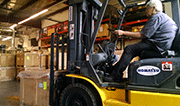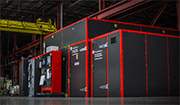E-Archive
Interview
in Vol. 19 - March Issue - Year 2018
Production Laser Peening Extends Component Life up to 20 Times

Doug Eberhart, Director of Sales for LSP Technologies, Inc.

Inside LSPT’s production laser peening facility

The Procudo® 200 Laser Peening System
Doug Eberhart, Director of Sales at LSP Technologies has spent over 30 years directing B2B sales efforts around the world. With specialized experience delivering sophisticated instrumentation and software products, Mr. Eberhart has been engaged with the high-tech industrial and manufacturing sectors throughout his distinguished career. He joined LSP Technologies in 2016.
(?) MFN: Thank you for this opportunity, Mr. Eberhart. Can you give us some background about yourself and your professional career?
(!) D. E.: I’ve been in sales all my life. My early career was focused on the Asia Pacific manufacturing sector, where I directed sales teams across the region. I’ve spent many years selling high-tech instrumentation and monitoring solutions, serving a range of industries from power generation to water treatment.
(?) MFN: What attracted you to LSP Technologies?
(!) D. E.: I was impressed by LSPT’s approach to innovation and customer service. This is a company that’s defining their industry, while working openly with customers in process development and application. As a sales representative, that makes my job easy. I have the freedom to collaborate as I work with customers to meet their needs. My role is to deliver actionable information, and I appreciate working for a company that values transparency in the sales process.
(?) MFN: Tell us about laser peening. How does the process work?
(!) D. E.: Laser peening is a mechanical surface enhancement process. We use a high-energy pulsed laser to strengthen metal components and increase their resistance to cracking and fatigue. Laser peening generates a high-pressure plasma burst on the part surface and sends a powerful shockwave into the material. The shockwave plastically deforms the metal and produces compressive residual stress.
(?) MFN: Who are your primary customers? What types of benefits do they enjoy?
(!) D. E.: Turbine engine manufacturers were the earliest adopters of laser peening, and we routinely treat fan, compressor, and turbine blades for major OEMs in the aerospace and power generation industries. Laser peening has proven to be the optimal solution to cracking and failure in these components, and it has saved our customers tens of millions of dollars in costs associated with maintenance, replacement, and failure.
We still generate lots of business from gas and steam turbine manufacturers, but we’ve recently made inroads into other industries that are embracing the life extension benefits of laser peening.
(?) MFN: What other industries have you been working with?
(!) D. E.: Transportation is a big one. Particularly trucks, tractors, earthmoving equipment and other heavy transportation equipment. These vehicles have many high-value parts in the engine and drivetrain that can be strengthened with laser peening. We’re also developing new applications for medical components, military hardware, and manufacturing equipment like metal forming dies. Typically, our customers want to extend their component service life and prevent fatigue cracking. Many are looking to reduce or replace their shot peening operations altogether. In each case we work alongside OEMs to optimize our laser peening process for their specific application or part.
(?) MFN: What is that process like for customers? How do you develop new laser peening applications?
(!) D. E.: Application development with LSPT is a collaborative process from day one. We gather information about a customer’s part, operating conditions, fatigue characteristics and failure mode, then we use sophisticated modeling software to optimize laser peening parameters for those conditions. Throughout this process, it’s important to maintain an open dialogue with the customer. We share data and details of our methodology so that our customers understand LSPT’s approach to enhancing their product. Most of our customers appreciate this transparency, and it helps ensure we deliver on customer expectations.
After establishing initial conditions, we begin processing metal coupons to gauge material effects and residual stress profiles. The next step is processing sample parts and subjecting them to fatigue testing. Once the customer is satisfied with the improved fatigue performance, we establish part-handling and qualification guidelines and move into production processing.
(?) MFN: Does LSPT perform all laser peening functions on-site in Dublin, Ohio?
(!) D. E.: Yes, we do all our production processing in Dublin. LSPT operates several in-house laser systems with specially designed processing cells to accommodate different components. We provide finite element modeling, residual stress and fatigue testing, even post-processing services like polishing or finishing. LSPT’s production team is experienced and professional; they’re really the best in the business.
One of the benefits of being a smaller company is that everyone works side-by-side to fulfill customer expectations. If I need guidance from one of our metallurgists or engineers, I simply walk down the hall. When the production team needs information about a recent order, our shipping coordinator is right there to fill them in. That culture of accessibility keeps everyone accountable and engaged, and we pass those benefits on to our customers with reliable, transparent service.
(?) MFN: Was LSPT the first company to perform laser peening? Do you have any competitors?
(!) D. E.: LSPT was the first company to commercialize laser peening as an industrial application. Much of the early research on laser peening took place here in Columbus at a research and development organization called Battelle Memorial Institute. Battelle operated a high-energy pulsed laser system, and during the 1970s and 80s, researchers used it to investigate the metallurgical benefits of laser-generated shockwaves. Several of our founding members worked on the technology at Battelle before establishing LSPT as a laser peening service and equipment provider. Since then, we’ve led the way in laser peening applications and innovation, securing dozens of patents and partnering with major OEMs.
We only have a small handful of competitors around the world, none of whom offer customers the option of purchasing production laser peening equipment for their facility. We’re in a unique position where we’ve created an in-demand market with few direct competitors. Our biggest competition comes from alternative surface enhancement technologies like shot peening and roller burnishing. These processes provide lower levels of fatigue improvement but have deeper market penetration.
(?) MFN: How do you distinguish laser peening from other surface enhancement applications? Is it really that different from shot peening?
(!) D. E.: Laser peening is superior to shot peening in many ways. The most important distinction is the residual stress depth achieved with laser peening. We regularly produce compressive residual stresses ten times deeper than shot peening, and we’ve reached as deep as 12 millimeters in certain applications. No other surface enhancement method really comes close to those results. Those deep compressive stresses enable laser-peened parts to last longer, perform better, and resist catastrophic failures that shot peening can’t prevent.
(?) MFN: How does laser peening produce such remarkable results?
(!) D. E.: The power of laser peening comes from the shockwave generated on the part surface. This powerful shockwave plastically deforms the metal to a much deeper level, leaving the material in a state of compressive residual stress. If you want to increase the depth of compressive stress, you need to increase the magnitude of the mechanical shockwave doing the work. Laser peening generates that shockwave with a high-energy laser pulse and high-pressure plasma burst. Shot peening uses the kinetic impact of tiny pellets or beads. There’s really no comparison. Laser peening is like shot peening on steroids, and it delivers stronger, more robust parts.
(?) MFN: What are some innovations that have reduced the price of laser peening for the commercial sector?
(!) D. E.: The biggest development has been increasing our processing speed to improve production volume and throughput. LSPT’s Procudo® 200 Laser Peening System delivers twenty high-energy pulses per second, making it the most powerful laser peening equipment in the world. At 20 Hz, we can process up to 180 cm2 per minute, increasing our capacity to process more parts and provide a quicker turnaround for our customers.
(?) MFN: What makes the Procudo® Laser Peening System so special?
(!) D. E.: Simply put, the system was designed by experts. LSPT has more collective laser peening knowledge under one roof than anywhere else in the world. Our engineers designed a next-generation system that’s fast, flexible, and reliable, making laser peening accessible to manufacturers of all industries and scale.
The critical feature is the incorporation of a diode-pumped laser to produce consistent pulses in rapid succession. Diode pumping provides the stability and beam quality necessary to realize high-repetition rate processing. It also dramatically reduces system maintenance requirements. Other key system features include the diagnostics package and process control. The Procudo® LSP System collects a wealth of data for each laser pulse and makes it accessible in real time. Operators can adjust laser parameters like energy and spot size to ensure residual stress profiles are optimized for each application. This flexibility allows us to easily switch between different components with different processing conditions, improving overall throughput and keeping costs low.
(?) MFN: What’s next for LSP Technologies?
(!) D. E.: We’re working on some exciting international ventures as the Procudo® Laser Peening System gains exposure around the world. LSPT is currently establishing laser peening facilities in China and Germany, and we’re working closely with manufacturers in both regions to develop new applications. This new high-throughput system is really a game-changer, and the sky is the limit regarding where we go from here.
(?) MFN: What would you say to potential customers who are interested in laser peening?
(!) D. E.: Laser peening offers tremendous return on investment. So much so that our customers are often shocked by the results. What would you say to extending your component life 3-20 times? How much would you save by reducing maintenance requirements, or using less material in your designs? These are all typical benefits of laser peening that contribute directly to the bottom line. For years, laser peening has been the best-kept secret in component enhancement. I’m here to let that secret out.
MFN would like to thank Doug Eberhart for this interview!
For Information:
LSP Technologies, Inc.
6145 Scherers Place
Dublin, Ohio 43016-1284, USA
Tel. +1.614.718 3000
Fax +1.614.718 3007
E-mail: ehoffman@lspt.com
www.lsptechnologies.com



























